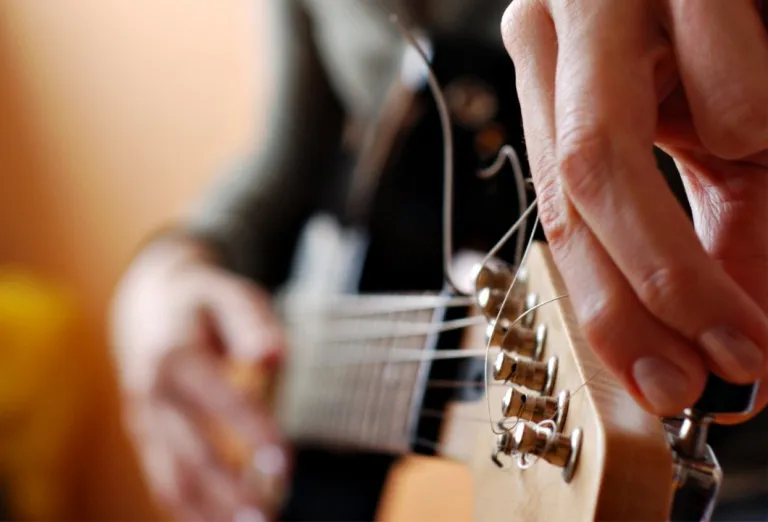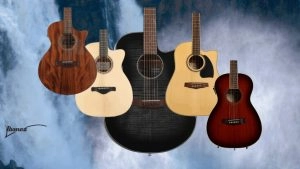Learning how to tune a guitar is one of the first things you should do as a beginner guitarist. You can’t make your chords and riff sound right if the guitar is out of tune!
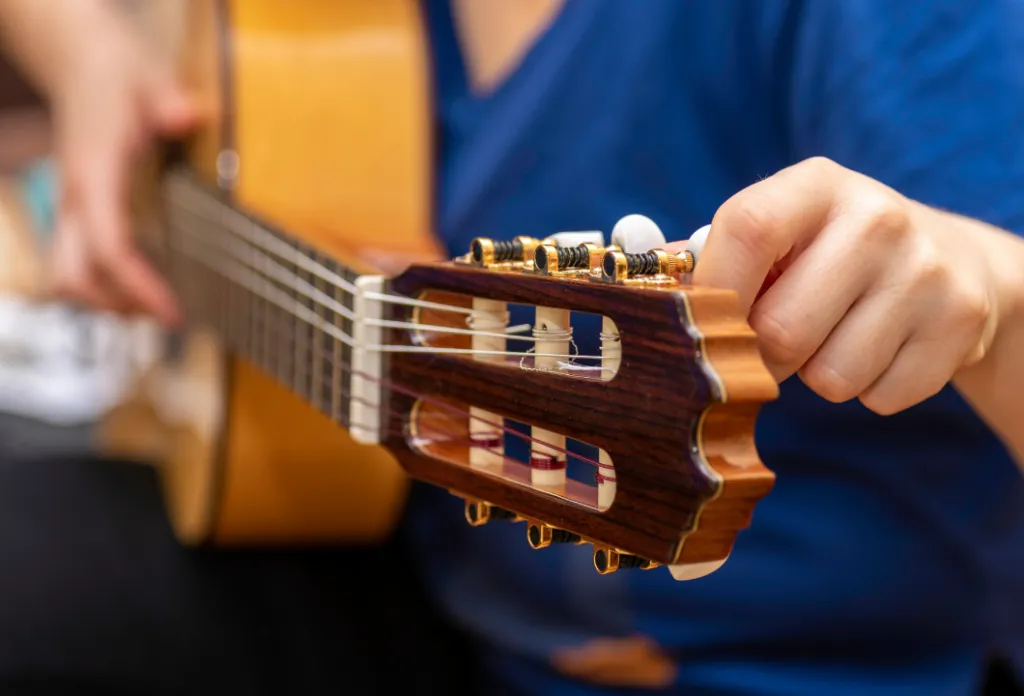
Learning how to tune a guitar is essential for many reasons. It ensures you get the best sound from your guitar and helps you develop and strengthen your aural skills (more specifically, relative pitch). These skills are building blocks that enable you to play guitar by ear.
Basics of Tuning a Guitar
Put simply, tuning refers to the adjusting of the tension of the guitar’s strings so that the pitches of each string match a specific desired arrangement of notes. So, when you’re figuring out how to tune a guitar, you can expect to tighten and loosen your strings.
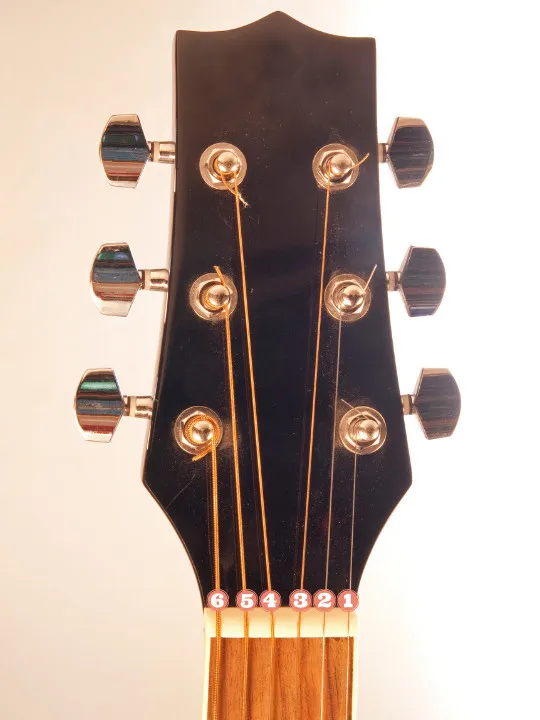
Generally, pitch in music is defined as the highness or lowness of sound. The thickest string has the lowest pitch on the guitar, and the thinner the string, the higher the pitch produced.
Although some guitars have more, a typical guitar has six strings. The strings are numerically labeled 1-6, from the thinnest (highest sounding) to the thickest (lowest sounding).
Remember how we said you were adjusting the strings so that the pitches matched a specific arrangement of notes? These arrangements are often referred to as tunings. There are various systems for tuning the guitar, e.g., drop D tuning, DADGAD tuning, open G tuning, etc. These are known as alternate tunings.
The most commonly used tuning system is the standard guitar tuning, which is what we’ll be concentrating on today.
• • •
Naming the Guitar Strings for Standard Guitar Tuning
We say we’re playing “open string notes” whenever we play the guitar’s notes without pressing down on the fret. In standard guitar tuning, the open string notes are tuned from the lowest (E2) to the highest (E4) to sound the pitches E, A, D, G, B, e (1). The small e shows the higher note.
So the string names for the standard tuning pattern are:
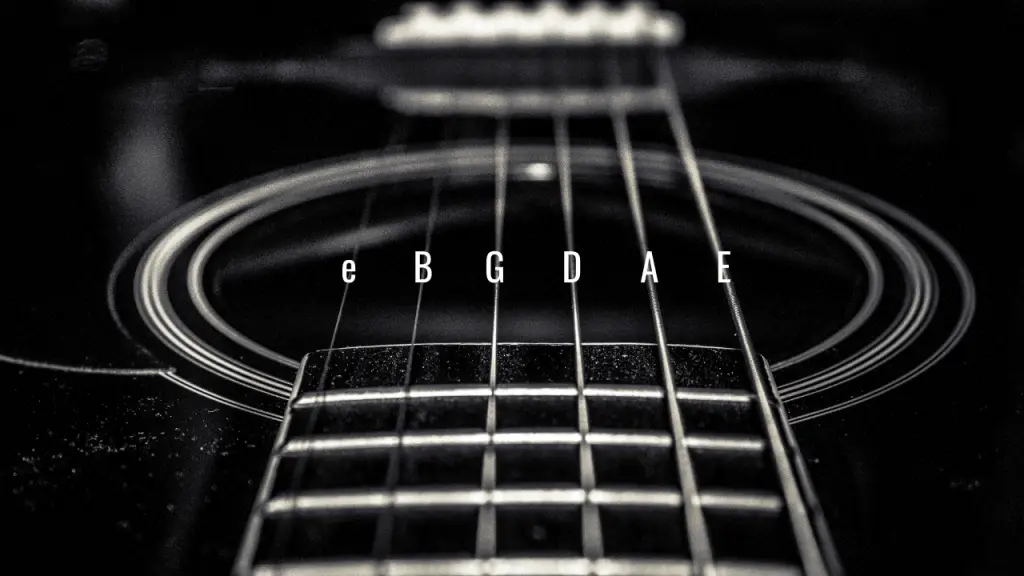
- E string
- A String
- D String
- G String
- B String
- e String
Easy right? Let’s make it even easier. You can use various mnemonic devices to remember the specific note names and order of the open strings.
- Eugene Ate Dynamite Good Bye Eugene (I know, right… what was Eugene thinking?)
- Even Ants Do Get Big Eventually
- Every Angel Does Get Baptised Eventually
Come up with some of your own unique mnemonic devices and share them with us in the comments section.
Machine Heads/Tuning Pegs on the Guitar’s Headstock
The machine heads or tuning pegs are the apparatus attached to the guitar’s headstock used in adjusting string tension.
The strings get higher in pitch the tighter they become and lower in pitch when loosened. Each string is attached to one machine head.
Check out our article on the guitar’s parts to get acquainted with basic axe anatomy.
• • •
How to Tune a Guitar with a Guitar Tuner
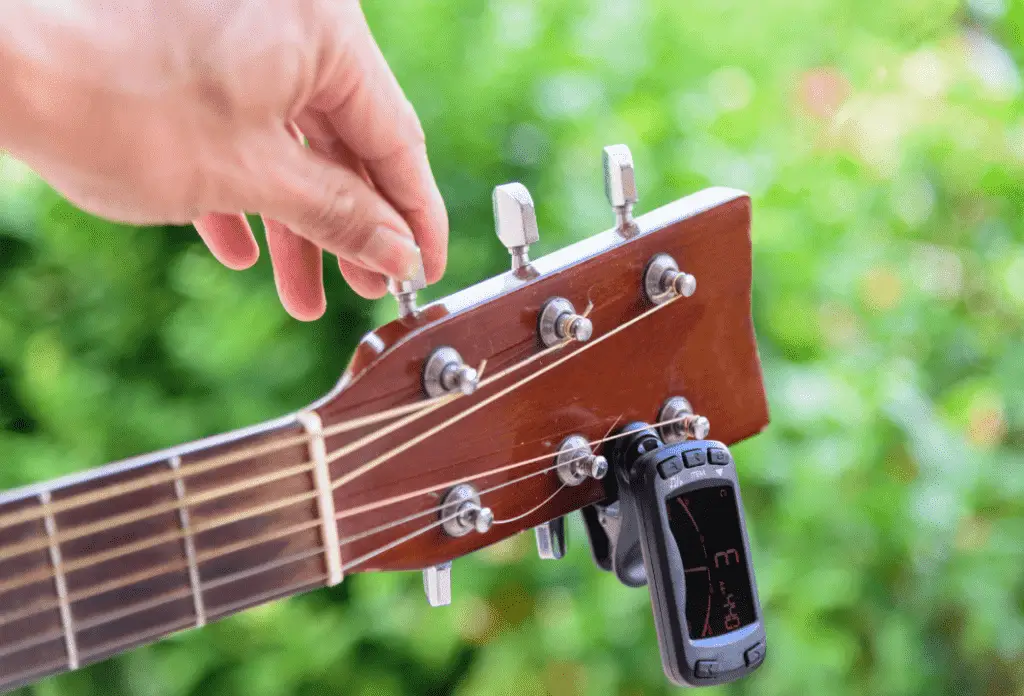
The term ‘tuner’ is used generally in music to describe anything that aids in setting up a musical instrument to a specific pitch. This includes anything like a tuning fork, pitch pipe, or various electronic tuners.
Most guitarists prefer electronic tuners. This is because of how efficient they are great for making the tuning process more efficient. Electronic tuners work by detecting the frequency of the vibrating string, processing the data, emitting information on the frequency, and directions on how to get to the desired pitch.
Unlike the early days of guitar, when getting an electronic tuner was complicated and expensive, today, there are various electronic tuners accessible to the everyday guitarist. The challenge then becomes choosing the right one to begin your guitar journey.
This means that guitarists need to understand the various types of guitar tuners to find the ones that suit them best.
• • •
Types of Electronic Tuners
Smartphone App Tuners

Arguably the most accessible type of tuner out there. These tuners use the microphone on a smartphone to pick up the frequencies of the vibrating strings. They’re probably the best option for someone just beginning their guitar journey.
The downside of these tuners is that they rely so much on microphone quality. Therefore, the interpretation of frequencies may be compromised on low-quality phones.
Clip-on Tuners
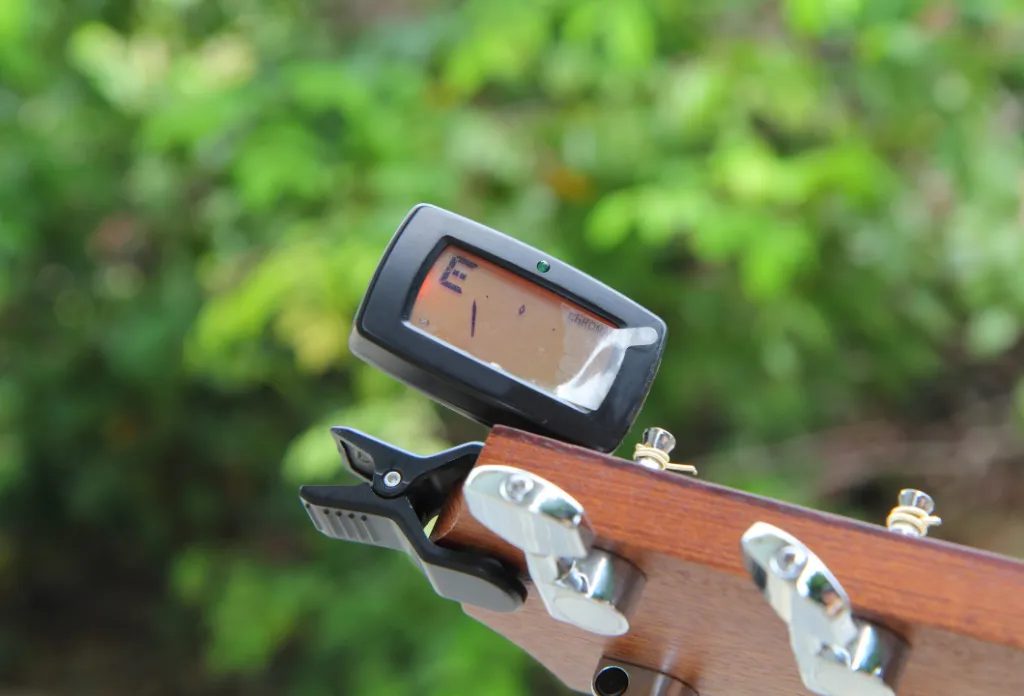
Aptly named, these clip onto the guitar’s headstock. They have an in-built sensor that picks up vibrations directly from the guitar. They are especially useful in noisy environments, as they rely on vibrations rather than sound. They are pretty affordable and most music shops and online stores carry them.
Pedal Guitar Tuners
By plugging your guitar into the input hole, the tuner interprets the signal it receives and displays the information on the pedal. If you play electric guitar most of the time, this is an excellent option to get you in pitch while at your gigs or band practice.
Strobe Guitar Tuners
These are perhaps the most accurate. They function by showing the difference between a reference frequency and the played frequency. However, they are usually quite heavy and fragile, making them impractical for everyday use. Put simply, these tuners are better suited for guitar pros who aim at perfection.
Polyphonic Guitar Tuners
Polyphonic guitar tuners stand on top as the most recent tuning revolution in a world full of single-string pitch tuners. They work by measuring the frequencies of all the strings at once. Players can strum all the strings simultaneously and identify the ones that need adjusting.
Handheld Tuners
These vary, with some using vibrations to pick up pitch and some using sound. They are portable and function on both electric and acoustic guitars. And while they can have the basic standard tuning notes, some are also chromatic tuners able to recognize up to 12 pitches.
There are many other types of electronic tuners out there. As a guitarist, knowledge of the various types of equipment can go a long way in helping you achieve the sound that suits your style of play.
• • •
How to Tune a Guitar Using Electronic Tuners
Most tuners have some sort of moving needle pointing on played notes and the desired pitch destination in the middle. Depending on where the needle points, you can adjust the specific string until the needle points to the middle.
So, to tune to standard tuning, you just have to get the needle pointing to the center of the tuner for the notes E A D G B e.
How to Tune A Guitar by Ear
This simply refers to the tuning of your guitar without using a tuner. Tuning by ear is by no means the easiest method, especially when you first try it.
Yet, all it takes is practice — and you will be able to tune your guitar by ear in no time if you practice often.
Relative Tuning
This is a method of tuning each string by relating it to the sound of the previous string.
However, it mostly requires that the low E string is in pitch. This method only helps get the right pitch intervals between the strings, so the string pitches may not be the exact EADGBe pitches.
For this reason, it might not be appropriate to tune your guitar by ear when playing with others unless you have perfect pitch (2) and can then use it as a reference for the exact frequencies of the notes.
How to Tune a Guitar by Ear With Relative Pitch
The relative method uses a reference point for tuning.
The reference note is often the A in the fifth open string and can be produced using one of the methods described below. A common method of relative tuning is the 5 5 5 45 method.
For example, if you play the fifth fret of the sixth string, you will hear an A note. Therefore, if you play the sixth string from the fifth fret, you need to have the same pitch as when you played with the fifth string open (no frets).

You can match the two notes if the fifth string is tuned correctly (or close). If it doesn’t sound the same, play the 6th string together and adjust until it becomes a single note.
Next, play the fifth string while pressing the fifth fret, and you’ll hear a “D.” This is the same note as playing the fourth string open (without pressing on any fret). If they don’t sound the same, the D string is out of tune, and you can adjust that string.
When you reach the third string, you need to press the fourth fret and open the second string to get a “B” note.
The last step is to play the second string while pressing on the fifth fret. This produces an “E” note that is an octave higher than the lower E produced on the sixth string. Simultanoeusly, you would play the first string open in order to adjust it until it produces the same E note you get by playing the second-string, fifth-fret combo.
How Do I Know if My Guitar Is in Tune?
If you do not have your tuner around, the quickest way to check whether your guitar is in tune is to try a few chords out on it. In simple words, when a guitar is tuned correctly, it will sound right.
How do I know what “right” sounds like, you ask? In the beginning, it is useful to focus on noticing a sort of undulating sound that emerges when you play two notes that are very close, but not the same. Your goal is to adjust the string you are trying to tune until that undulating sensation disappears.

But the truth is an ability that takes some time to develop. From the first moment you tune your guitar, you begin a journey of training your ears to recognize the sound your guitar produces when it is tuned.
This is then what will be “right.” Over time, whenever your guitar is not tuned to the correct notes, you will be able to recognize it is not sounding right.
Of course, you can always use other instruments as referencing points to determine the pitch accuracy of each string. For example, you could play an E on an electric keyboard and play an E on your guitar and see if they match.
How Often Should You Tune Your Guitar?
You should tune your guitar every time you are about to play it. Guitars can also go out of tune sometimes while we play. In the event you suspect this, always check to ensure it’s tuned.
What Should I Do to Ensure My Guitar Stays in Tune?
Replace your strings often. Old strings eventually lose their ability to maintain correct pitch. And make sure you change your strings the right way.
• • •
Stay Tuned
Hopefully, now you know how to tune a guitar and the different tuners available. I recommend getting a decent electronic tuner, but you shouldn’t shy away from tuning by ear. It’s an essential skill to learn.
• • •
References:
- Stack Exchange, “What do the terms E2 A2 D3 G3 B3 E4 actually mean?,” as published here: https://music.stackexchange.com/questions/32715/what-do-the-terms-e2-a2-d3-g3-b3-e4-actually-mean
- UChicago News, “What Is Perfect Pitch?,” as published here: https://news.uchicago.edu/explainer/what-is-perfect-pitch

